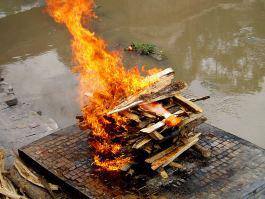Changes in Cremation Bylaws, threaten 5000-year-old custom

Proposed changes to Aucklandís cemetery and cremation bylaws are threatening 5000 years of traditional Hindu practice, says the Funeral Directors Association.
Chief Executive Katrina Shanks says the changes proposed by Auckland Council are upsetting many ethnic groups, and Hinduís in particular, who told funeral directors they should have been consulted before anything was drafted.
ìThe proposed changes are insensitive to the cultural, religious and social needs of families and are too restrictive.î
Funeral Directors Association of New Zealand met the Auckland Indian Association in Auckland and said its members were surprised to learn of the proposals.
Indian community spokesperson Shanti Patel said Hinduís regarded the ceremonial aspect of placing a casket into the cremator as a key responsibility for the immediate family following a death.
ìThis has been part of our custom for more than 5000 years but the council wants to limit the number of people who can participate in this ceremony to a maximum of two. What about a father who has four sons?î he says. ìHow do you tell a son he cannot perform this important rite for his father?
ìThe Auckland Indian Association (AIAI) is upset the council failed to tell us of its proposals.
ìMany of the changes impact on our community directly, and the council should have been more sensitive to our cultural needs.î
Mrs Patel said they only became aware of the changes through the efforts of the Auckland District of the Funeral Directors Association (FDANZ).
ìSubmissions on the bylaws closed on 5 May but we were unaware of this close-off date and would like the chance to have our concerns heard so we can lay out our cultural needs.î
Mr Dil says other concerns discussed at the meeting included a lack of clarity around items that may be placed in the casket with the deceased, and where ashes may be scattered following cremation.
Proposed changes to Aucklandís cemetery and cremation bylaws are threatening 5000 years of traditional Hindu practice, says the Funeral Directors Association. Chief Executive Katrina Shanks says the changes proposed by Auckland Council are upsetting many ethnic groups, and Hinduís in particular,...
Proposed changes to Aucklandís cemetery and cremation bylaws are threatening 5000 years of traditional Hindu practice, says the Funeral Directors Association.
Chief Executive Katrina Shanks says the changes proposed by Auckland Council are upsetting many ethnic groups, and Hinduís in particular, who told funeral directors they should have been consulted before anything was drafted.
ìThe proposed changes are insensitive to the cultural, religious and social needs of families and are too restrictive.î
Funeral Directors Association of New Zealand met the Auckland Indian Association in Auckland and said its members were surprised to learn of the proposals.
Indian community spokesperson Shanti Patel said Hinduís regarded the ceremonial aspect of placing a casket into the cremator as a key responsibility for the immediate family following a death.
ìThis has been part of our custom for more than 5000 years but the council wants to limit the number of people who can participate in this ceremony to a maximum of two. What about a father who has four sons?î he says. ìHow do you tell a son he cannot perform this important rite for his father?
ìThe Auckland Indian Association (AIAI) is upset the council failed to tell us of its proposals.
ìMany of the changes impact on our community directly, and the council should have been more sensitive to our cultural needs.î
Mrs Patel said they only became aware of the changes through the efforts of the Auckland District of the Funeral Directors Association (FDANZ).
ìSubmissions on the bylaws closed on 5 May but we were unaware of this close-off date and would like the chance to have our concerns heard so we can lay out our cultural needs.î
Mr Dil says other concerns discussed at the meeting included a lack of clarity around items that may be placed in the casket with the deceased, and where ashes may be scattered following cremation.









Leave a Comment